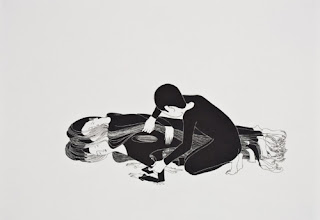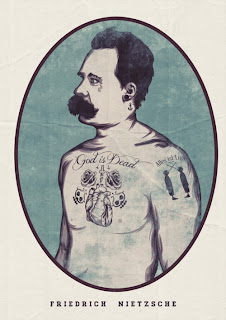We are
living in century of technology and it is out of the topic to even discuss if
that affects our daily routine. Obviously it does. I could not say it`s bad. Our lives are
becoming so fast, that we just need something that could make our days much
easier. But moment where I am starting
to get worried is when it reaches the art. If we compare beautiful grotesque
paintings from Renaissance, with artwork created in last 60 years (obviously we
could go in much further history, but for now…) we are more likely to see those
visual works being mostly digitalized. Just to understand what I am trying to
say, we must look at terminology.
Digital art is so called contemporary art in which computer
technology is used in a wide variety of ways. It includes computer software,
video equipment, sound mixers, digital cameras and other digital tools (The
Columbia Electronic Encyclopedia, 2007).
Opposite
digital art, our well-known classic art (antique paintings) is known for using
such techniques as oil paint, graphite pencils, pastels etc.
The problem I
came up with was - If we put digital artwork next to old hand-drawn painting –
how do we feel different about those two?
So here is an example of original painting of
Mona Lisa by Italian artist Leonardo de Vinci (painted between 1503 – 1506) and
digital photography done by unknown art student recently. I we study those two
examples closer we can see something being slightly changed. In original,
although it`s not completely clear because of digital copy, we can see brush
strokes and texture of paint being still existent. And if we look at digital photography – it`s
clear to see that color palette is slightly changed and air brush is used to
soften edges where color makes the most of contrast. Basically, digital
photograph is changed enough so we can feel `handprint` of Leonardo de Vinci
missing.
So how all this digital revolution started,
that made us to look at the world of art from slightly different perspective?
Technically digital art was born
when the first IBM computer was used in conjunction with a digital printer to
make a photo out of asterisks. This crude and ugly photo was the first digital
picture ever printed. This occurred in the late 1970s. Since then, printers
have improved greatly and so has the quality of the medium.
What most normal humans consider art didn’t
arrive until computer programs could create a wide array of colors, images and
games. This period flourished in the early 1980s. During this period we saw
digital dot matrix printers produce almost life-like pictures out of tiny dots.
(Chloe Calc, 2010)
On
another note. As digital media was introduced, we found easier ways/shortcuts
how to make art more enjoyable. It was
different. Artists started to mix hand-drawn with digital tools adding sound
and video, which became so called `installation`. That was just another
creative way how to express emotions and point of view. Sounds brilliant! We,
as human beings, always love to discover and invent new things, that`s just how
our nature works. And there is nothing unnatural about it. Although, if we look
from other perspective. There is a down
side for all this.
As you stand in gallery of modern art. Great
example is installation I saw recently. A mirror attached to the wall with
added motor that makes installation vibrate whenever someone passes by. Must
say – I was really impressed. But while observing the artwork and trying to
understand what was in head of artist, who made this. I could not get in his
head really. What was missing, I think was the presence of the artist
himself. I so call it Aura. There was no
fingerprint. That little magic was missing.
While viewing a painting – original work, you see all the brush strokes,
all the textures color does to canvas. That automatically makes us visualize
how artist does his work, what his feel and emotions are. If brush stroke is
strong and sharp we read automatically his point of view and approach.
Unfortunately, I could not feel the same emotion while viewing installation I
mentioned before. But still, I love modern art, just because it doesn`t make
any bonds not to be creative. And at the
same time, lack of presence of the artist makes viewer confused. Seems like
presence of Aura is non-existent. I
consider, we rather feel presence of vague inorganic sense.
It is quite fundamental to look at photography.
Photographer captures the same moment that original classicist painter, drawer,
cartoonist etc. does. Things his eye
captures. If we look at essay Walter Benjamin wrote in 1935 ”Does Aura Exist in
Digital Art”, he clearly states – photography is reproduction of clear
landscape.
First, process reproduction is more independent of the
original than manual reproduction. For example, in photography, process
reproduction can bring out those aspects of the original that are unattainable
to the naked eye yet accessible to the lens, which is adjustable and chooses
its angle at will. And photographic reproduction, with the aid of certain
processes, such as enlargement or slow motion, can capture images, which escape
natural vision. Secondly, technical reproduction can put the copy of the
original into situations, which would be out of reach for the original itself.
Above all, it enables the original to meet the beholder halfway, be it in the
form of a photograph or a phonograph record. (Walter Benjamin, 1935)
So, what
Walter Benjamin is trying to say there? Basically, while doing mechanical
capture, something important is left out - artistic production. And this is only my personal opinion. I feel
more presence of an artist while observing those phenomenal unique brush
strokes that are unrepeatable than photograph, where you just know that
photographer stands in positions changing lens of camera and shutter speed
following with pressing a one tiny button and that’s it. Work is done and we
can put it in a posh art gallery. Then we can look at those photos while
sipping a wine and enjoying mint
conversation of what we feel like about this so-called artwork. But most things
we could come up with would be – the feel of captured environment or portrait.
There certainly would be message missing, how the photographer, himself, feels.
That’s all because of this fingerprint or so-called Aura missing. To summarize, for photography, exhibition
value slightly shrinks, as we don’t feel the ritual of artistic production involved
in as high level as in painting. It
might sound picky, but I feel, that photography steps back on a certain level
so we are not experiencing certain point – presence of artist and his aura.
Might be his style repeating in every each photography so that his ‘signature’
is readable, but not his point of view in certain moment of the feel with which
he did the photograph.
Another
point is important to mention - sculpture. Sculpture has been done since the
prehistoric age, where Egyptians and Greeks came up with this art form using
stone, clay and bronze. Interesting is a
fact, that sculpture first was not used for artists to express their creativity
of emotional observing. Sculpture had to
be something sacral, so it was used for religious rituals. Furthermore, during
the Middle Ages and 18th century artists did their sculpture in
churches and temples to gain their notoriety and influence. That was shown in
their grotesque gothic manner. When 20th century hit the threshold
sculpture became more modern and influential. It made a big step away from
well-known realism and Greek manner. Artists started to look around the allover
the world just to succeed with something original and unseen. It became more
than digging into other cultures to come up with something yet undone and
mixing different approaches. Nowadays, sculpture is something yet indefinable.
Artists are using different techniques, materials and methods. Many traditional rules have been lifted and the artist
is no longer limited by the popular, accepted style as they have been
historically. (Robin Antar, 2009)
Furthermore, the big breakpoint in sculpture came when 3D printing
emerged. The patent was granted in 1977 to Wyn
Kelly Swainson.
In Swainson’s system the laser caused covalent cross-linking at the surface of
the liquid monomer and the object being manufactured rested on a tray that was
gradually lowered into the vat. (FutureShapes, 2009) Basically, that was a new,
much faster way how to reproduce, before done sculpture on monitor. Before 3D
printing was invented, there were 3 ways how to make solid objects: cutting
material out of block solid piece; adding material to crate shapes and forms;
filling prepared forms with liquid consistence. Now you just have to create
well planned 3D image using graphic tools on software so later you can print in
out on machine using solid block material. How it works. Machine using
information you have sent cuts shapes out of block material using laser of a
little knife, depends how printer is generated.
This was introduced in sculpturing industry as so-called rapid
prototyping. The process itself is much quicker and easier. You have complete
control using machine device that calculates numbers for you.
As far as I am concerned, I call this completely inartistic and off from
any art form whatsoever. Only thing you do is design acceptable 3D form on
computer and then let the entire hardest part machine to do. I mean this is
miles away from so called sculpture. Obviously, it looks great, but structure
itself is so cold and plain. At the same time we could call the most recent BMW
and art as well. The most important thing it’s missing is the artistic
production. It is clearly easy to see, that generic machine has been involved
to create this piece of ‘sculpture’. If we talk about Aura being in 3D print
work, I must disagree. It is hard to read what author meant while doing this or
what idea it represents. It’s just coming up with new idea or technique. It is
time consuming question, when 3D printing is going to be presented on a level
so we can actually feel the presence
of an artist or at least the artwork itself. And by that I mean on emotional
basis.
To answer the question: “Does Aura Exist in Digital Art?” It’s still
fairly hard to define – yes or no. On the level of feeling the vibe from what
eye of an artist captures, it does exist, no matter what art form of what
technique is used. Artist still captures the moment he sees or what’s in his
head and presents it in is way and style. Might be digital painting, photograph
or just rough sketch. Thing I’m worried is. If we still feel the presence of an
artist itself, while looking a digital print or previously mentioned 3D print.
It is incredibly important to see and feel effort artist is putting while
producing his or her masterpiece. Emotional emphasis is well needed while we
are reading his visual work. I could compare it with novel. While reading non-fiction,
you know it’s real and author is not sharing just with what he sees, but what
he feels as well, complete opposite is fiction where you deal with fantasy of
author not really knowing, how he feels personally of what is happening.
Reference
Darren Rowse, 2000
What the Mona Lisa Can Teach You About Taking Great Photos [online]
Available at:
[Accessed 07.05.2012]
The Columbia Elctronic Encyclopedia, 2007
Digital Art [online]
Available at:
[Accessed 07.05.2012]
Robin Antar, 2009
A Brief History of Sculpture [online]
Available at:
[Accessed 08.05.2012]
FutureShapes, 2010
History of 3D printing [online]
Available at:
[Accessed 08.05.2012]
Chloe Calc, 2011
A Brief History of Digital Art [online]
Available at:
[Accessed 07.05.2012]
Galeriesas, 2012
Fred Leforge’s 3D printed sculpture at Galerie SAS [online]
Available at:
[Accessed 08.05.2012]

















